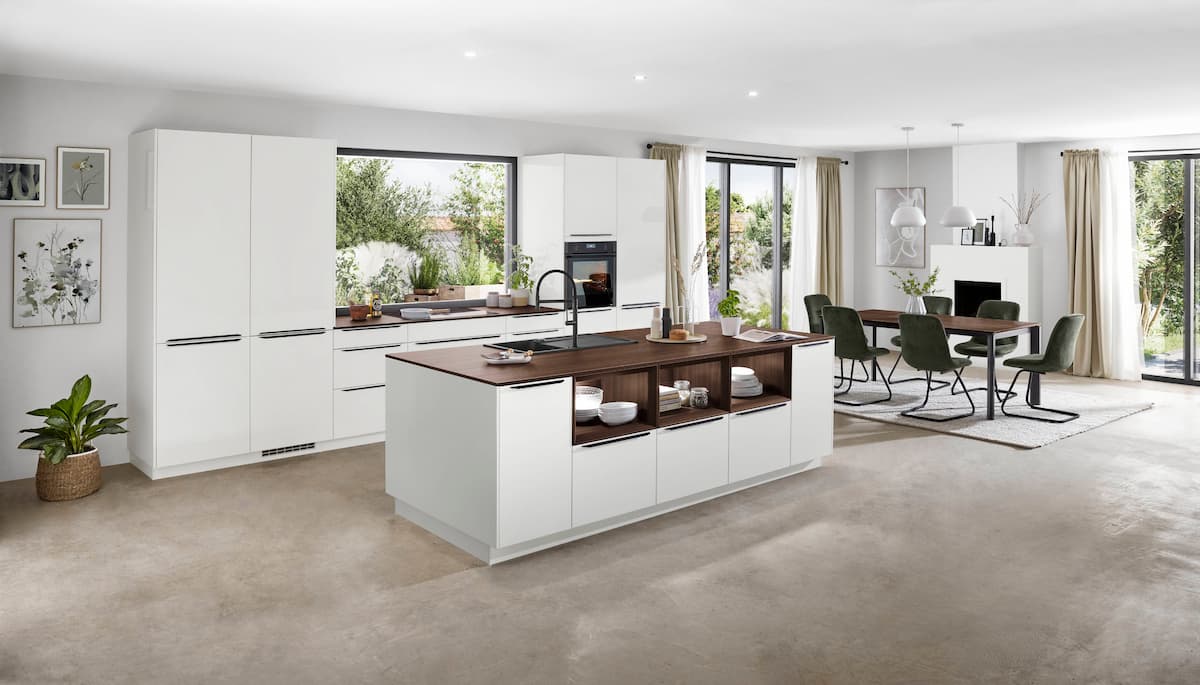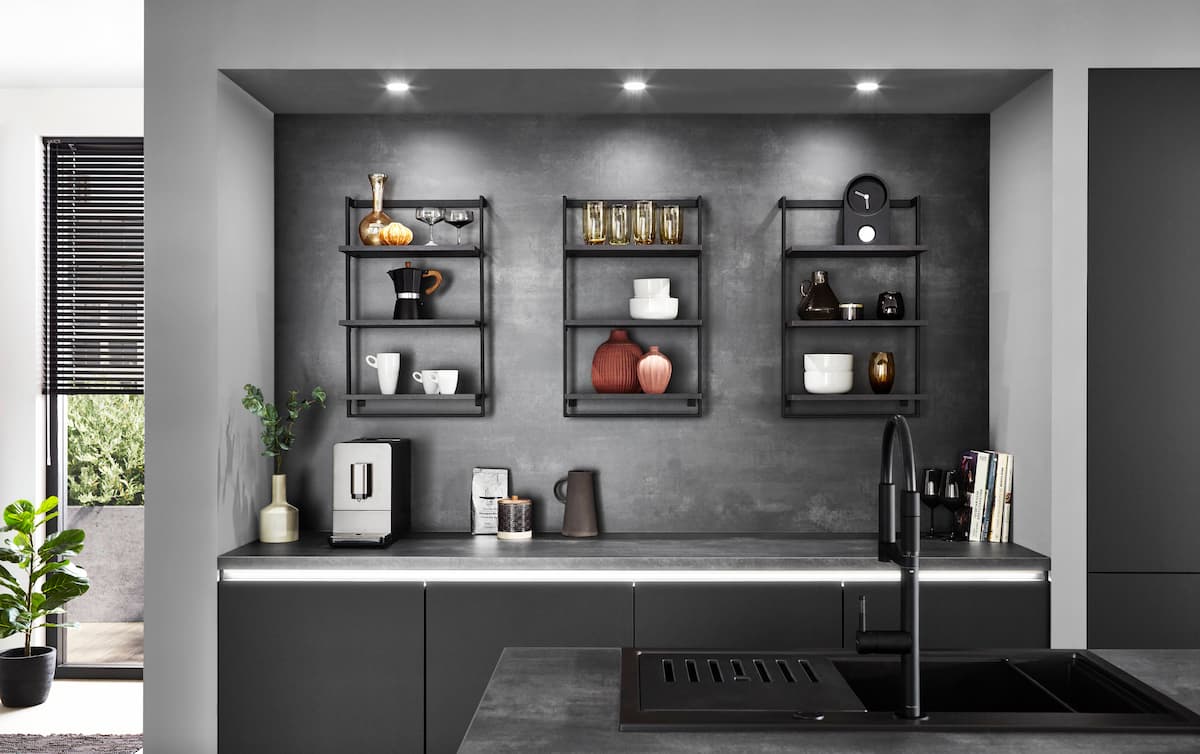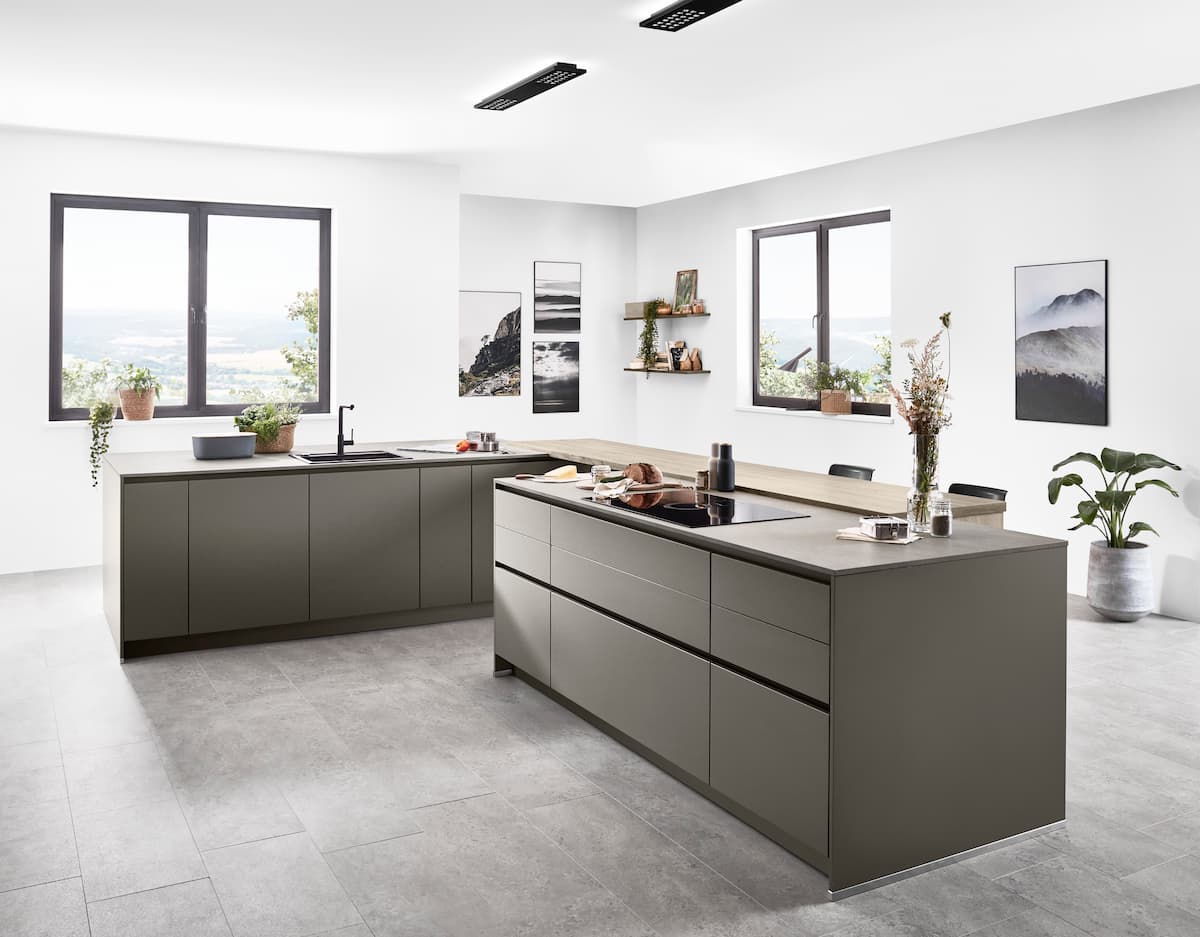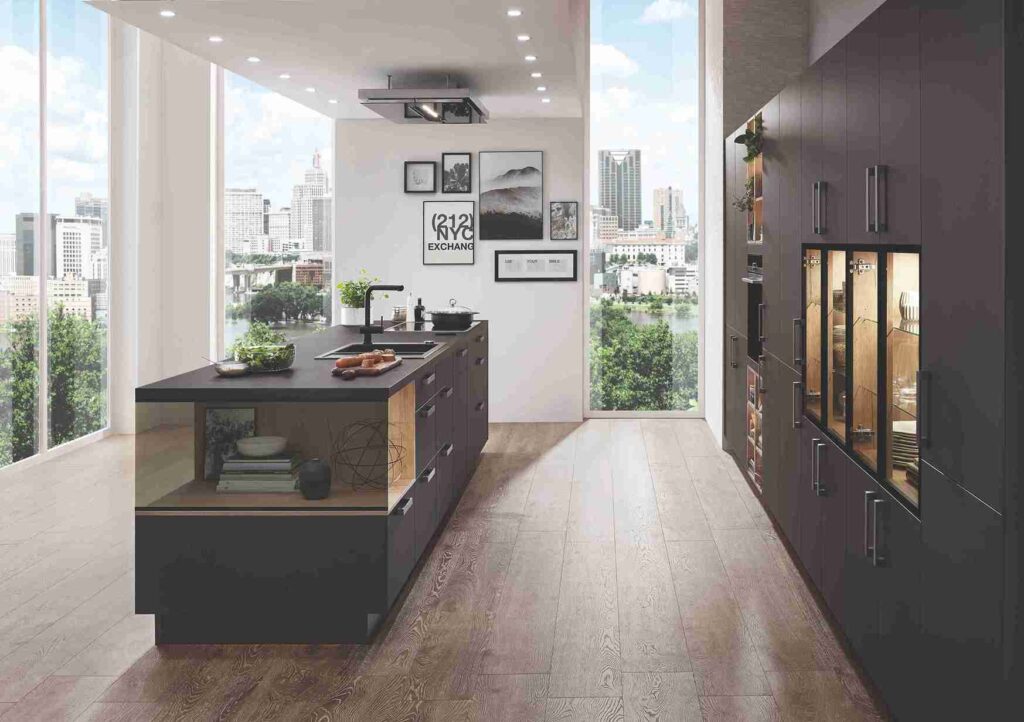
Picture this: you’re whipping up a delicious meal in your kitchen, chopping, sizzling, and sautéing away. Suddenly, a glass of wine tips over, leaving a crimson stain spreading across the floor. Or, maybe it’s the clang of a dropped pot, sending a shiver down your spine and leaving a dent behind. The kitchen, unfortunately, is always at risk of spills, being subject to dropped objects, and being worn down by the wear and tear of daily life.
The flooring of your kitchen is one aspect that is often underrepresented. It’s the foundation that endures the daily hustle and bustle, silently absorbing traffic, spills, and cleaning routines. But not all floors are created equal. Choosing the right material is crucial for ensuring your kitchen remains beautiful and functional for years to come.
This guide equips you with the knowledge to decide on the best kitchen flooring material for your specific needs, delving into the factors that separate the resilient from the easily damaged, ensuring you make an informed decision. Scratch resistance, water resistance, wear and tear – we’ll cover it all, along with tips for easy maintenance. Let’s ensure that the foundation of your kitchen is up to scratch!
Understanding Kitchen Flooring Durability
What Makes a Kitchen Floor Durable?
Durability, in the context of your kitchen floor, signifies its ability to withstand the daily onslaught it faces. This encompasses:
Heavy traffic
We don’t really think about it, but the more time you spend in a space, the more it’s subject to constant foot traffic from you, your family, and guests. A durable floor should bear this weight without showing excessive wear and tear.
Spills and splatters
Kitchens are inherently prone to spills, from water and wine to grease and food. A durable floor should resist stains and be easy to clean without warping or deteriorating.
Dropped objects
Pots, pans, and utensils can all come crashing down. A durable floor should be able to handle these impacts without cracking, denting, or chipping.
Cleaning routines
Regular cleaning is essential for maintaining a hygienic kitchen. A durable floor should be compatible with your cleaning methods (e.g., mopping, scrubbing) without succumbing to harsh chemicals or excessive moisture.
Flooring Material Composition and Construction
The foundation of a durable floor lies in its material composition and construction. Let’s explore these factors:
Material Composition
While there isn’t one true best kitchen flooring material, each of the following materials have inherent strengths and weaknesses that will help you better make your decision.
Porcelain and cermaic tiles
These boast exceptional hardness, ranking up to 7 and 8 on Mohs scale of hardness (Mohs scale basically measures scratch resistance, with human fingernails ranking at 2, and diamonds at 10), making them highly scratch-resistant. However, they can be susceptible to cracks if a heavy object falls on them.
Natural stone (granite, marble)
These offer luxurious aesthetics and natural scratch resistance (especially granite). However, some stones like marble are porous and require sealing to prevent staining.
Luxury vinyl tile (LVT)
This resilient material absorbs impact, making it resistant to dropped objects. However, it can scratch or dent with heavy items.
Vinyl sheet flooring
Affordable and comfortable underfoot, it’s vulnerable to tears and punctures.
Laminate
While budget-friendly, laminate isn’t water-resistant and can easily scratch.
Hardwood
Beautiful and classic, hardwood is susceptible to scratches and water damage.
Beyond material, construction also plays a role. The thickness of tiles or vinyl planks, for example, affects their durability. Similarly, the wear layer on LVT and laminate – a protective topcoat – determines their resistance to scratches and fading. Finally, the installation method plays a part. Properly installed subfloors are crucial for optimal performance, especially for tiles and hardwood flooring.

Surface Texture and Durability
The surface texture of your floor also impacts its durability. A smooth surface might be easier to clean but can be more prone to scratches. A textured surface, on the other hand, offers better slip resistance but might trap dirt and grime more easily. Consider the trade-off between aesthetics, ease of cleaning, and potential for scratches when deciding on the best kitchen flooring material for you.
Evaluating Specific Flooring Options
Now that we’ve unpacked the key factors influencing kitchen floor durability, let’s delve into the specifics of popular flooring choices:
Ceramic and Porcelain Tile
Durability Champions
Ceramic and porcelain tiles are renowned for their exceptional durability. They rank high on the Mohs scale of hardness, making them highly resistant to scratches and everyday wear. Additionally, their glazed surface is non-porous, meaning they resist stains and moisture, perfect for spills and splashes.
Cleaning Champions
Their smooth, non-porous surface makes them incredibly easy to clean. Regular mopping with a mild cleanser is all you need to maintain their pristine appearance.
Style Kings and Queens
With a vast array of colors, patterns, and finishes, ceramic and porcelain tiles offer immense design flexibility. You can mimic the look of wood, stone, or even create intricate mosaics to personalize your kitchen.
The Not-So-Perfect Picture
While incredibly tough, ceramic and porcelain tiles can crack if a heavy object falls on them. Additionally, they can feel cold underfoot, especially in colder climates. The grout lines between tiles can also be prone to staining if not properly sealed and maintained.
Natural Stone (Granite, Marble)
Luxurious
Natural stone like granite and marble elevates the aesthetics of any kitchen with their timeless elegance and natural beauty. Granite, in particular, boasts exceptional scratch resistance, making it ideal for busy kitchens.
Stain Resistant
Granite is naturally stain-resistant, but some lighter-colored marbles are porous and require regular sealing to prevent staining.
Durability with Maintenance
While naturally hard, stone can chip or crack with heavy impacts. Regular sealing (especially for marble) is crucial for maintaining their resistance to stains and etching from acidic liquids.
Consider the Comfort Factor
Like ceramic and porcelain tiles, natural stone can feel cold underfoot. Area rugs can help address this concern.
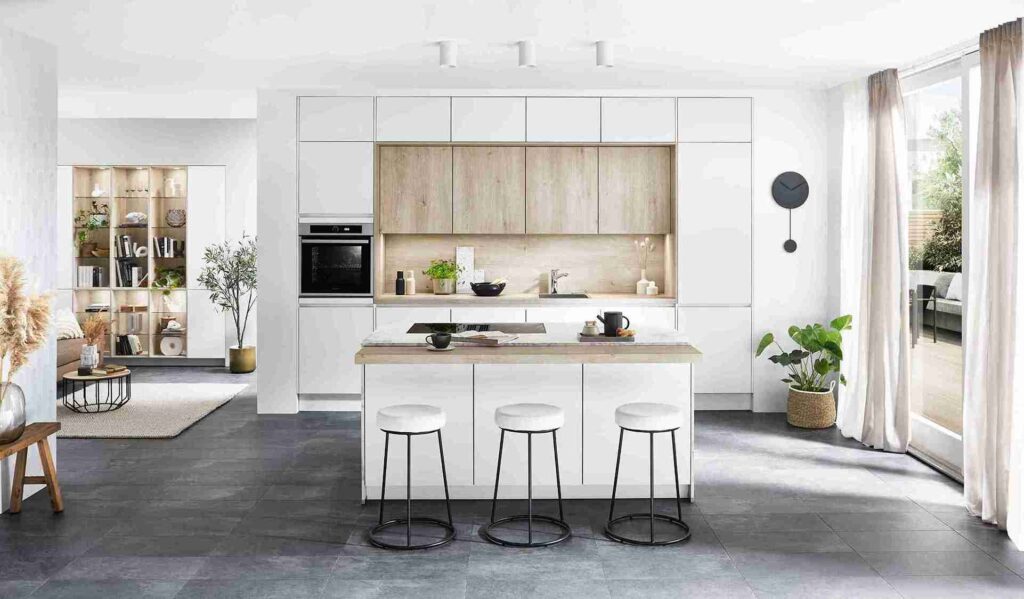
Luxury Vinyl Tile (LVT)
Resilient
LVT shines in its resilience. Its flexible core absorbs impact, making it resistant to dropped objects and comfortable underfoot. This is a great choice for kitchens where you spend a lot of time standing.
Waterproof
LVT is generally waterproof, making it ideal for areas prone to spills and splashes. This eliminates worries about water damage, a common concern with some other materials.
Style Chameleon
LVT offers a stunning array of designs that mimic the look of wood, stone, and even ceramic tile. This allows you to achieve the desired aesthetic without the drawbacks of some natural materials.
Not Invincible
While durable, LVT can scratch or dent with heavy objects or sharp utensils. Choose a wear layer thickness appropriate for your kitchen traffic level for optimal performance.
Vinyl Sheet Flooring: The Affordable Choice
Budget-Friendly
Vinyl sheet flooring is the most affordable option on this list. It’s a great choice for kitchens where cost is a primary concern.
Waterproof
Similar to LVT, vinyl sheet flooring is waterproof, making it ideal for areas prone to spills. This eliminates worries about water damage that can plague other materials.
Comfort Underfoot
Vinyl sheet flooring offers a comfortable walking surface, making it easier on your legs during long periods of cooking.
The Achilles’ Heel
Unfortunately, vinyl sheet flooring is susceptible to tears and punctures from sharp objects. It may not be the most durable option for high-traffic kitchens with busy cooks.
Style Considerations
While vinyl sheet flooring has come a long way in terms of design options, it might not offer the same level of aesthetic variety as some other materials.
Laminate: A Wood Lookalike with Caveats
Budget-Friendly Wood Alternative
Laminate offers a beautiful wood look at a fraction of the price of hardwood flooring. This makes it one of the best kitchen flooring materials for homeowners seeking a warm and inviting feel in their kitchen without being too heavy of an expense.
Easy Installation
Laminate flooring is known for its relatively easy installation, making it a DIY-friendly option for some homeowners.
Not Water Resistant
A major drawback of laminate is its lack of water resistance. Spills can cause the planks to swell and warp, potentially requiring replacement. This makes it a risky choice for areas prone to frequent spills.
Scratch Susceptible
Laminate can easily scratch with everyday use or pet claws. Maintaining its pristine look requires careful handling.
Limited Lifespan
Compared to other options, laminate flooring has a shorter lifespan and may need to be replaced sooner, especially in high-traffic areas.
Hardwood: Timeless Beauty with Maintenance Needs
Classic Elegance
Hardwood flooring adds timeless beauty and warmth to any kitchen. It increases a home’s value and creates a sophisticated atmosphere.
Naturally Warm Underfoot
Hardwood offers a naturally warm and comfortable walking surface, making it a pleasure to stand on while cooking.
Scratch Magnet
Hardwood is susceptible to scratches from everyday wear and tear, dropped objects, and pet claws. Maintaining its pristine look requires regular care and refinishing.
Water Woes
Similar to laminate, hardwood is not water-resistant. Spills can damage the wood, so immediate cleanup is crucial. This makes it a risky choice for kitchens with frequent spills.
Maintenance Demands
Hardwood flooring requires regular cleaning, sweeping, and occasional sanding and refinishing. This ongoing maintenance might not be suitable for everyone.
Choosing the Right Material: It’s All About Your Needs
As you can see, each flooring material has its own set of strengths and weaknesses when it comes to durability in a kitchen environment. The best kitchen flooring material for you will depend on your priorities, budget, and lifestyle. Consider factors like:
- Traffic level: How much foot traffic will your kitchen floor endure?
- Spill potential: Are you prone to spills, or is your kitchen a haven of clean precision?
- Maintenance needs: How much time and effort are you willing to invest in maintaining your floors?
- Budget: How much are you willing to spend on your new kitchen floor?
- Style preferences: What aesthetic are you hoping to achieve in your kitchen?
By weighing these factors and understanding the specific advantages and disadvantages of each material, you can make an informed decision that will ensure your kitchen floor remains beautiful and functional for years to come.
Additional Considerations for Kitchen Durability
The Importance of Subflooring
While the surface material takes center stage, don’t underestimate the role of a strong subfloor. This hidden layer beneath your chosen flooring provides a level and stable base. For optimal performance, especially with tiles or hardwood, ensure your subfloor is properly leveled, structurally sound, and free of moisture.
Unevenness or weakness in the subfloor can lead to cracking, creaking, or uneven wear on your beautiful new floor. Consult with a flooring professional to ensure your subfloor is up to the task before installation begins.
Area Rugs for Enhanced Durability
Area rugs can be your allies in the battle for kitchen floor durability. Placing them in high-traffic areas like entrances or in front of the sink can help protect your floor from scratches, spills, and tracked-in dirt. They can also add a touch of color and pattern, further personalizing your kitchen’s style. Choose area rugs with a non-slip backing to prevent them from becoming a safety hazard. Remember to clean your area rugs regularly to prevent dirt and grime buildup.
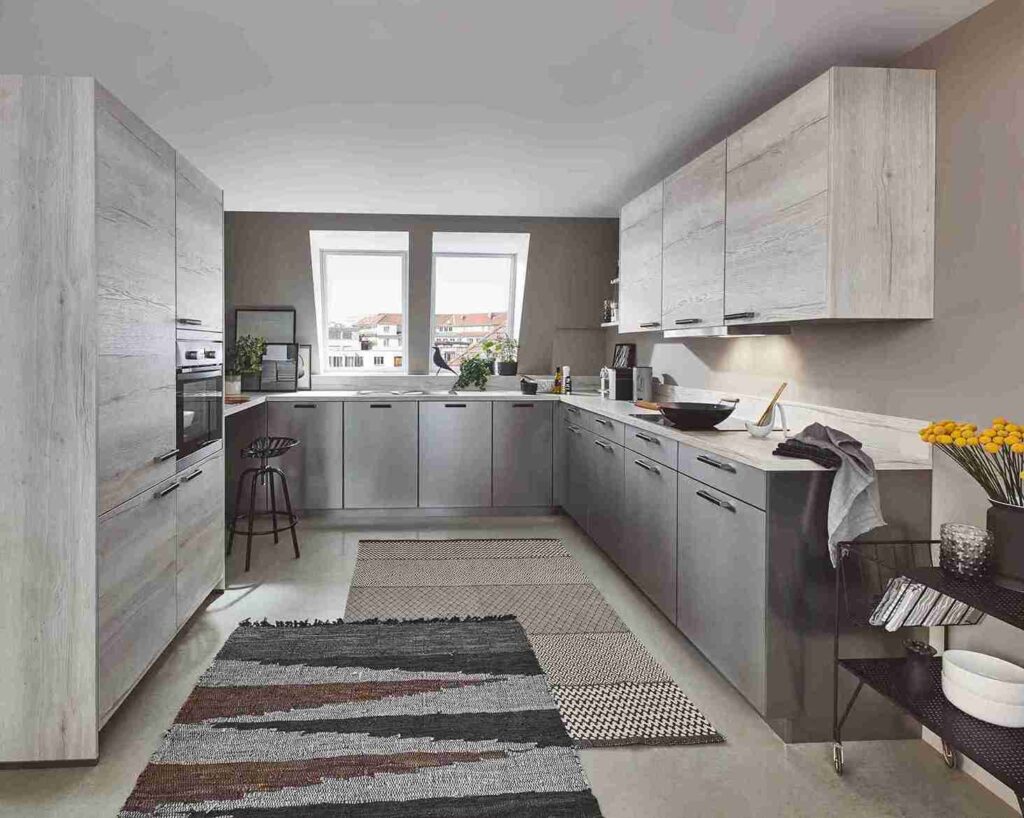
Cleaning Tips
Every flooring material requires specific cleaning strategies to maintain its lifespan and beauty. Here are some general tips:
Regular Sweeping and Mopping
Develop a routine for sweeping up crumbs and debris daily. Follow this with routine mopping using the recommended cleaning solution for your specific flooring type. Avoid harsh chemicals or excessive moisture, as these can damage some materials.
Immediate Spill Cleanup
Spills happen, but the key is to act fast. Blot up spills with a clean, absorbent cloth to minimize moisture absorption. For tougher spills, consult the cleaning recommendations for your specific flooring material.
Proper Use of Cleaning Tools
Using the right tools is crucial. Avoid abrasive scrubbers that can scratch delicate surfaces. Microfiber cloths are a versatile option for most flooring types. Consider using a vacuum cleaner with a soft brush attachment for deeper cleaning, especially for crevices and corners.
By following these tips and choosing the right cleaning products for your specific flooring, you can extend the life of your kitchen floor and keep it looking its best for years to come.
Making the Final Decision
Remember, there’s no absolute “best” kitchen flooring material for every kitchen. The best choice depends on your unique needs and priorities. Consider your budget, desired aesthetic, traffic level, and how much time you’re willing to invest in maintenance.
Don’t hesitate to revisit the key factors discussed throughout this guide. Weigh the pros and cons of each material option and choose the one that best suits your vision for a beautiful and durable kitchen floor.
If you’re still unsure, consulting with our experts at German Kitchen Design, who can provide valuable guidance and ensure you make an informed decision that will enhance your kitchen for years to come. Our team’s expertise extends beyond cabinetry and appliances – we understand how every element, including flooring, contributes to a cohesive and functional kitchen design. Contact us today to learn more!

